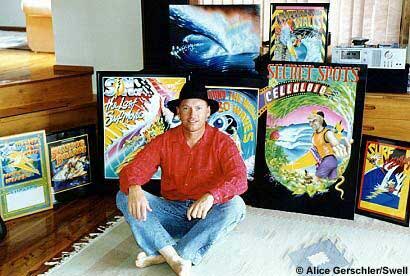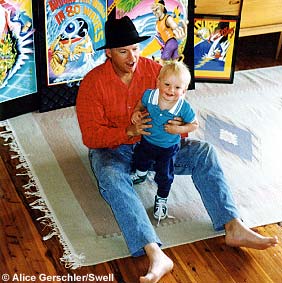|
|
|
|
IN MEMORY OF
|
 Friend of many, myself included, Chris was a man of immense talent and drive who loved surfing and made it his life's work. |
 Chris and his son, Josh. Josh Bystom has published a website to "to keep my dads legacy going" and you can get to it by clicking on http://www.chrisbystrom.com . The website is well worth a visit. In addition to a beautifully written tribute written by Josh, the Chris Bystrom Website gives you access to a complete list of Chris' films and their release dates, DVD's, back issues of Pacific Longboarder and "The Glide," plus posters and t-shirts.
|
The phone call came from a mutual friend who lived in Australia, but I still found it difficult to believe that someone as vital and full of life as Chris could actually be dead. I spent the rest of the day on the phone and the internet trying to get confirmation. Finally, I got through to Daryl Barnett, manager of Chris Bystrom's Retro Groove Surf Shop. It was inescapable. Chris' car was hit by a truck on New South Wales' notorious Pacific Highway. His car had inexplicably swerved into the truck's path and hit the semi-trailer head-on. According to news reports, he died "instantly." No longer would I pick up the phone and hear a strange accent, "Dis iss ze prezeedunt uf ze Gggggerman Rrrrepooblish. Iss Count von Fargulstein von Burgerbaum ut ze kassel today?" or "This is the IRS, Mr Feigel. We're calling about your last tax return." Chris and I never met face to face. Nevertheless we built a strong and lasting friendship over the all too brief time we knew each other. A friend in California had sent me an issue of Pacific Longboarder magazine with an article about Miki Dora (Volume 3 Number 1). I disagreed with how it portrayed Miki. So I fired off a letter to the magazine's publisher and editor, Chris Bystrom. A week or so later, I picked up the phone and it was Chris calling from Australia where the magazine is based. Naturally, I expected him to ask me about the letter, but instead, he asked if I was the same Bob Feigel who'd written "Feigel Fables" in Surfguide magazine back in the 60's. It turned out that he was one of FF's old fans, which immediately made me suspect his sanity. Then he told me something that blew my socks off. "It's said that one of your fables was prophetic, and I agree with that." I asked him to explain and he said, "Rip van Nerdwinkle" (which appeared in the "Malibu" issue of Surfguide - November 1964) predicted the shortboard revolution several years before it actually happened ... and I want to republish it." My first answer was, "No." I explained that, except for my letter about the Miki Dora article, I hadn't written anything for a surfing magazine since Surfguide went down the gurgler and that I wasn't sure I wanted to start again in 1999. As anyone who knew Chris can attest, "No" was not a word he understood. So I ended up agreeing and a beautifully illustrated version of the original "Rip Van Nerdwinkle" appeared in Volume 3 Number 3 - the same issue in which he published my letter about the Miki Dora article. He also announced that I would be Pacific Longboarder's New Zealand correspondent. From then on Chris and I spoke almost weekly - often more. Most calls were about the magazine, its direction and the major two part article he asked me to write about the history of New Zealand surfing. But some were personal calls about what was going on in his life and his relationships ... and it was these latter calls that cemented our friendship and trust. We almost met face to face later in mid-1999 when Chris plugged me into an ambitious project. He wanted to build an "Extreme Sports" theme park that would feature surfing, skateboarding, snowboarding, kitesurfing, etc. He was a walking idea factory. At the time, my wife was visiting her aunt in England, and Chris wanted me to fly over to Australia to work with both Chris and a young friend of his who was a top management and marketing consultant. Since part of my background was marketing communications, Chris wanted my input in the mix. Unfortunately, Chris failed to inform me about his plans until the last moment and I couldn't get a visa for Australia in the timeframe he'd set. Nor could I simply leave our small, 7 acre "lifestyle block" and our "mob" of 12 sheep unsupervised on such short notice. So Chris arranged for one Stuart O'Neill to fly over to New Zealand and work with me on the project at our place on Vinegar Hill. For the next few days Stuart and I put in twelve hours days and somehow produced a comprehensive report that came to the conclusion that, while it was a great idea and had lots of potential, Chris' proposal wouldn't be viable without major outside investment. It wasn't the news Chris wanted to hear, because he wanted to retain total control of the project ... but it was the advice we'd been paid to provide. Stuart stayed long enough for us to become good friends and enjoy a fair few beers, some superb bottles of Aussie red (Stuart arrived with the maximum allowed by customs) and hours of talk story in front of our fireplace. Stuart had heard the news of Chris' death from his mother, who'd passed the accident scene early that day and recognized Chris' car. Radio news reported a fatality at the same spot and Stuart thoughtfully called me with the news before I could hear it from an impersonal source. Chris Bystrom was warm, funny, creative, unpredictable, invigorating, challenging and sometimes maddening. And even today, whenever my phone rings, I still hope it might be Chris on the other end. I miss him very much. His legacy includes a string of popular surf movies and videos (Blazing Boards, Gravity Sucks, Soul Patrol, Blazing Longboards, Living Long, to name a few amongst many), a classic book on the renaissance of longboarding, 'The Glide', his Retro Groove Surf Shop in Coolangatta and the most elegant and memorable issues of Pacific Longboarder - the magazine he published and edited until its sale the year before his death. When I
last spoke with Chris just two weeks before his death, he was planning yet another surf film expedition, another trip to California to buy and sell
surfing memorabilia and looking forward to riding many more waves. May your generous spirit surf joyously in
the hand of God ... and save a few for me. In Memory of Chris Bystrom © Robert R. Feigel, 2007 - All Rights Reserved |
FROM SWELL.COM:
|